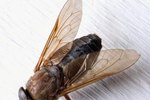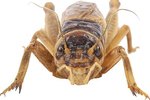
Fly genders mirror those of more advanced species. When they mate, the males introduce sperm into female bodies, and females develop and lay eggs to create the next generation of flies. Fly gender, in addition to determining which aspect of the mating ritual they will perform, also has effects on their aggressiveness and their perception of space.
Fly Reproduction
Flies depend on sexual reproduction, which means mating requires a male and a female fly to produce offspring. Flies generally engage in courting or mating behavior, after which they copulate. The female then produces eggs, assuming she can eat enough and find a suitable medium in which to lay them. The number of eggs female flies lay, how often they lay and the mating rituals required to copulate vary among species.
Fighting Behavior
Fighting behavior has been studied extensively in fruit flies, which belong to 484 different genera in the order Diptera. Male fruit flies are considerably more aggressive than females, and their aggression rises as they age. While they are relatively peaceable on the first day or two of their lives, they become more and more aggravated on subsequent days. Fighting behavior includes wrestling, lunging, chopping, kicking, head butting, fencing and holding. Dominant flies may induce submissive or avoidant behavior in other males.
Spatial Differences
Flies also appear to look at the world they inhabit differently based on sex. Whereas male flesh flies (Sarcophaga crassipalpis) seem to define territories as their own and attempt to bring females back to them to mate, female flesh flies showed no such need for defined territories. Males also seem less tolerant of each other’s company than females do, likely because of territorial instincts. Despite this difference in spatial need, females have a higher need for a regular food source, as they can't produce eggs without adequate nutrition.
Mating Behaviors
Female and male flies exhibit mating behaviors based on gender. House flies (Musca domestica), for instance, mate when the male fly locates a suitable female, gets close enough to her, and “strikes” or “jumps.” This can occur either when they’re both walking or resting on the same surface, or when both are in flight. The “strike” is defined as the male fly leaping onto the female from the front, side or back, at short range. He then latches on and they copulate. Evidence exists that genes may control mating behavior in fruit flies: when these genes are missing in males, they do not court, and when present in females, they court other females in an imitation of the males.
References
- University of Nebraska-Lincoln: Flies in the Home
- The New York Times: Fruit Fly Gender Varies at the Cellular Level
- Harvard Gazette: Fruit Fly Bouts Show Gender-Specific Styles
- United States Department of Agriculture: Fruit Fly (Diptera -- Tephritidae) Classification and Diversity
- East Tennessee State University: Gender-Specific Differences In Spatial Behavior Of The Flesh Fly, Sarcophaga Crassipalpis
- University of Florida: House Fly
- Ohio State University: Studies on the Mating Behavior of the House Fly, Musca Domestica L.
Photo Credits
-
Visage/Stockbyte/Getty Images
Writer Bio
Sarah Moore has been a writer, editor and blogger since 2006. She holds a master's degree in journalism.



